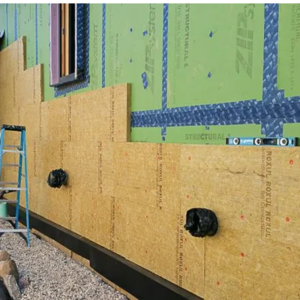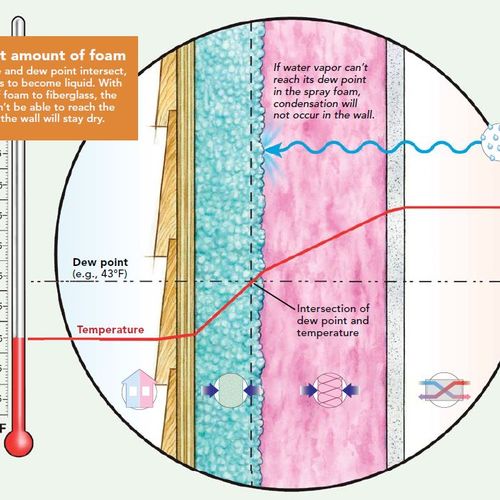
The last 15 years have seen more changes in building technology and science than the 50 years that came before. Maybe 100 years.
Weekly Newsletter
Get building science and energy efficiency advice, plus special offers, in your inbox.

This article is only available to GBA Prime Members
Sign up for a free trial and get instant access to this article as well as GBA’s complete library of premium articles and construction details.
Start Free TrialAlready a member? Log in















14 Comments
Justin,
Good blog and hard to disagree with anything you've written. I will provide a bit of defence for architects (although it's hard to argue they haven't been their own worse enemies over the years).
The lack of detailing and scarcity of site visits by architects is almost entirely a result of clients not wanting to pay the fees necessary for those services, and on larger projects substituting other consultants in their place.
I'd also defend the time architecture students spend on pie-in-the-sky projects. One of the most noticeable changes in high performance houses over time has been their incorporation of other design concerns, not just energy efficiency. So they are now both more pleasant to live in and beautiful. A big impediment to wider adoption of the ideas of the early 1070s energy pioneers was no one wanted to live in their houses. Early Passive Houses suffered from the same problem. Good houses are more than just the sum of their well thought through and executed details.
To add to Malcolm's comments, few of the architects who are really putting in the work to stay on top of the game and provide as much useful input as possible are driving very nice cars. Architecture school, ideally teaches the young architect how to learn more than specific knowledge which will be outdated in a few years. Ideally a school of architecture would connect students with people and resources in the field. There still seems to be a huge disconnect and so much potential. Hint: architecture grads can make excellent carpenters.
This. We get this all the time on the civil engineering side. You want a sign off for the servicing? Oh, but the pipes are flat or have failed the mandrel test due to improper installation? And the $5000 for an inspector on your multi-million dollar site was deemed too expensive? It's penny-wise, pound foolish.
Architects, engineers, general contractors, site supers, etc. can make a huge difference on a site. Trades, even the very best ones, will be concentrating on their trade--as they should! It's not their job to make sure their sub-trade fits with everything else. That's the designer's job. But when nobody gets paid to make sure everything gels during construction, it all just gets covered w/ drywall and forgotten until something goes wrong.
Side note--I can only speak for the engineering side here. Many engineers will spec a product that they are familiar w/ the added phrase "or approved equivalent." They do this because often that specific product has: a). been approved in that municipality, b). been installed before on one of their projects successfully, c). has extensive installation instructions so that contractors can easily reference how it is to be installed, and/or d). that product has its own engineering staff who is willing to sign off and provide contractor direction (ie. large retaining walls are an example of this). If the client wants an alternative product, things get interesting. This is also why companies often give "lunch and learns" to engineering companies. If the engineer is unaware of the product and its features/value, they will very rarely spec it.
Also, an engineer may say "by others" simply because they are referencing something to which they do not have professional expertise. Going back to retaining walls, many civil engineers will do the grading for a site and require a retaining wall of a certain height. They may not have the skills to design that retaining wall; thus, "by others" simply means that a qualified professional is needed to design that component of the site.
Sounds pretty dire. Are there any upsides? Has CAD software been keeping pace with these changes to help automate a lot of these details? I was rather shocked at the coarse level of detail in my construction drawings. They probably haven’t really changed much in decades.
Yes, large products now have Building Information Modeling (BIM). There are different levels of detail you can spec for a project. Higher detail = higher cost. Some examples from Autodesk:
https://www.autodesk.com/solutions/bim
As much as I hate Autodesk, the combination of Infraworks, Civil3d, and Revit is pretty powerful for large projects.
You wouldn't typically see that level of detail for a single detached residential dwelling due to cost. If you wanted that, your best bet would be to find a designer fluent w/ some of the residential modeling software. Something like Sketchup with some of the detail apps. Something like Sketchup + Medeek:
http://design.medeek.com/plans/search.pl
I've used his plug-ins w/ some pretty good results for personal projects. There are many more alternatives (ie. Chief Architect, SoftPlan, etc.), but keep in mind that their deliverables will typically cost more than someone just using AutoCAD. Also keep in mind that just because it's a powerful piece of software, they may not know how to use it to design a "GreenBuildingAdvisor" style house. I can attest to that personally. I had someone use SoftPlan to design my house (I'm busy w/ my own job so the idea was to offload the work). They were unfamiliar w/ the general concepts of a Pretty Good House and the results would have just created problems during construction. I had to take the plans, redraw them, and then track down some drafters I trusted to fix their mistakes. It was an expensive lesson--both financially and time-wise. I console myself in that the problems would have been worse if we tried to fix it at the construction phase.
Designers w/ already completed designs are your better bang for the buck. As soon as you go for your one-off, "dream house" the price goes up.
Coming from a field where automation is the name of the game wherever possible and labor is very expensive; I don't understand why software like that wouldn't conform to economies of scale for smaller jobs.
From a consumers perspective, those completed designs don't really include details like rainscreens, how much impermeable insulation they will have, or that they are going to advise just filling all of your rafter pays with ludicrously expensive spray foam with no method for mitigating thermal bridging. The only thing you get is a blurb on their site for how green they are and that those details will be worked out with an engineer. The one exception may be working with pre-made panels like bensonwood.
CAD software is probably more powerful today than in past times. The issue with detailing isn't with the software used to produce those details -- it's the designers behind the mouse.
As an example...we use AutoCAD C3D 2020 at work for civil site design. Most of the advances w/ CAD have made certain design tasks more efficient. But I could still lay out a site, grading, utilities, etc using CAD 2016 or older (Not much has changed since 2016, tbh). Bottom line is... if you can dream it and it's constructable... I can draw a detail for it.
As mentioned in another comment, I believe the problem is most clients aren't willing to pay the $ required to produce a bomber set of construction drawings. More details... especially custom details... is more time and $. Additionally, most details are most likely "standard details" or details copied from previous jobs/houses. It's a lot easier to keep using the standard wall section detail... copy and paste... and may edit one or two things than to either modify a detail or draw one from scratch for a potentially complicated wall assembly.
One thing that isn't talked about out in the open enough is a frank discussion between architect & owner about whether they're paying for the honda or the ferrari. Is the scope to do a ferrari w/ all the bells and whistles, tight tolerances, and proprietary materials? Or is it the honda? With a basic but durable design with materials that have been used successfully over the past few decades? Whichever it is... the construction drawings will reflect that. And some of the confusion/let down arises when the client expected the ferrari, but paid for the honda.... both in terms of the drawings and the final built product.
I hope over time the huge proliferation of building assemblies we currently see (as witnessed on GBA) settles down to two or three for each climate zone. The present
state of having high performance houses designed where each project gets bespoke detailing isn't sustainable - and also means the innovative assemblies specified may or may not work. Once a few become the new standard, detailing will be easier and a lot less important.
Amen to that. Just post a question on GBA and see how many different assemblies will be recommended by creative builders:)
I have high hopes for the "standard" drawings coming out of BC in 10 years. What w/ the excellent illustrated guides coming from BC Housing, I'm hoping that a number of firms incorporate that knowledge into their deliverables:
https://www.bchousing.org/research-centre/library/residential-design-construction&sortType=sortByDate
I understand why they don't but if they released the Sketchup (it looks to be Sketchup to my eyes) models or CAD used in those guides, designers would latch on to them voraciously.
Jaccan,
The government generated reference materials available in BC are superb. It's a small province. You wonder why other much larger jurisdictions don't produce them for their climates?
Their effect, and those of recent code changes, has been an easily noticeable improvement in the construction, efficiency and durability of buildings here. If I wasn't so lazy, I could spend every spare moment at a useful seminar or workshop.
I would like to see builders and architects budget enough time and money to revisit a representative sampling of past projects at 1 year, 5 years, and 10 years after completion. Each project we do is, in its way, an experiment. If we really want to be good building scientists, we need to be observing first-hand the results of those experiments. We spend too much time being theoreticians; we need to become better empiricists, I think.
It's amazing what you can learn about what works and what doesn't by going back to past projects. Sometimes you learn that you can use what are supposed to be really good products, and follow the manufacturers' instructions to a T, and still have failures. You also learn (no surprise) that more complex systems and assemblies tend to deteriorate faster and require more maintenance than simpler ones. Alex Gordon probably had it right when he advocated for "Long life, loose fit, low energy," which is as good a definition of a simple building system as I've seen.
As an added benefit, when my remodeling company implemented a program of periodic return visits to past projects, it turned out to be the single best marketing strategy we had ever come up with -- a totally unexpected outcome.
Agreed. I think one of the most important disconnects boils down to basic design. I continue to get plans on my desk (I'm a builder) with increasingly complicated designs, with a variety of materials. Each elevation or wall may have as many as 5-10 different interfaces/connections/flashings, etc. that need to be figured out. Heck, there may be 3 different window installs on one elevation. This increases cost on all fronts, from the Architect drawing all of those details(if you're lucky) to the trades figuring them out on site. This also increases the possibility of failure. I also think that "innovative" materials have allowed us to be tricked into ignoring basic building fundamentals. Things like building orientation, site specific designs, overhangs.....yada yada.
I totally agree that it falls on all of us - but I think we need to look beyond site coordination and peer groups and internet searches (Although I love all those things....) We need to start with education, and start early. When was the last time you saw a young person in a basic building science seminar? Never - it's all us old farts trying to learn new tricks...... I'm getting a bit tired of contractors whining about the lack of skilled labor - we need to start "growing our own"! I think EEBA is hip to this, and has been trying to promote getting younger folks involved. Anyway, thanks for the article and the opportunity to rant.......
PS - Yes, Robert Swinburne, agreed! The connection in education between design and construction should be fluid!!
Onward.
Good piece, thanks. The problem with residential construction is that much of it is sold as a commodity (both production new construction and custom renovation and new homes). There is rarely enough money in the budget to take the time and pay talented people what they are worth to think things through carefully before they are executed, inspect the work, and make corrections as needed before work is covered up by the next trade. Most purchasers don't understand quality construction because they can't see it. They can see vaulted ceilings, stone counters, and the like which is what sells most homes.
One comment on your reference to ASTM standards - if anyone expects to understand how to do something from a standards document, they have the wrong expectations. I have never seen one that is written in a readable form or has clear directions on how to meet those standards. That is left to others (or often no one) to figure out.
Log in or become a member to post a comment.
Sign up Log in